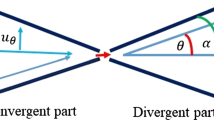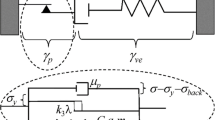Abstract
The characteristics of the flow field of both viscous and viscoelastic fluids passing through a curved pipe with a Navier slip boundary condition have been investigated analytically in the present study. The Oldroyd-B constitutive equation is employed to simulate realistic transport of dilute polymeric solutions in curved channels. In order to linearize the momentum and constitutive equations, a perturbation method is used in which the ratio of radius of cross section to the radius of channel curvature is employed as the perturbation parameter. The intensity of secondary and main flows is mainly affected by the hoop stress and it is demonstrated in the present study that both the Weissenberg number (the ratio of elastic force to viscous force) and slip coefficient play major roles in determining the strengths of both flows. It is also shown that, as a result of an increment in slip coefficient, the position of maximum velocity markedly migrates away from the pipe center towards the outer side of curvature. Furthermore, results corresponding to Navier slip scenarios exhibit non-uniform distributions in both the main and lateral components of velocity near the wall which can notably vary from the inner side of curvature to the outer side. The present solution is also important in polymeric flow processing systems because of experimental evidence indicating that the no-slip condition can fail for these flows, which is of relevance to chemical engineers.









Similar content being viewed by others
References
Finlay, W.H.: Perturbation expansion and weakly nonlinear analysis for two-dimensional vortices in curved or rotating channels. Phys. Fluids A 1, 854–860 (1989)
Hayat, T., Noreen, S., Alsaedi, A.: Effect of an induced magnetic field on peristaltic flow of non-Newtonian fluid in a curved channel. J. Mech. Med. Biol. 12, 1–26 (2012)
Hoque, M.M., Alam, M.M., Ferdows, M., Anwar Bég, O.: Numerical simulation of Dean number and curvature effects on magneto biofluid flow through a curved conduit. Proc. Inst. Mech. Eng. H J. Eng. Med. 227, 1155–1170 (2013)
Keshavarz, M.Z., Kadeem, L.: 3D pulsatile flow in a curved tube with coexisting model of aortic stenosis and coarctation of the aorta. Med. Eng. Phys. 33, 315–324 (2011)
Ali, N., Sajid, M., Abbas, Z., Javed, T.: Non-Newtonian fluid flow induced by peristaltic waves in a curved channel. Eur. J. Mech. B Fluids 29, 387–394 (2010)
Kumar, V., Aggarwal, M., Nigam, K.D.P.: Mixing in curved tubes. Chem. Eng. Sci. 61, 5742–5753 (2006)
Cheng, K.C., Akiyama, M.: Graetz problem in curved pipes with uniform wall heat flux. Appl. Sci. Res. 29, 401–418 (1974)
Dean, W.R.: Note on the motion of fluid in a curved pipe. Philos. Mag. 4, 208–223 (1927)
Dean, W.R.: The stream-line motion of fluid in a curved pipe. Philos. Mag. 5, 673–695 (1928)
Eustice, J.: Experiments on stream-line motion in curved pipes. Proc. R. Soc. Lond. Ser. A 85, 119–131 (1911)
Topakoglu, H.C.: Steady laminar flows of an incompressible viscous fluid in curved pipes. USSR J. Math. Mech. 16, 1321–1337 (1967)
Berger, S.A., Talbot, L., Yao, L.S.: Flow in curved pipes. Ann. Rev. Fluid Mech. 15, 461–512 (1983)
Guan, X., Martonen, T.B.: Simulations of flows in curved tubes. Aerosol Sci. Technol. 26, 485–504 (1997)
Naphon, P., Wongwises, S.: A review of flow and heat transfer characteristics in curved tubes. Renew. Sustain. Energy Rev. 10, 463–490 (2006)
Hooman, K., Hooman, F., Famouri, M.: Scaling effects for flow in micro-channels: variable property, viscous heating, velocity slip, and temperature jump. Int. Commun. Heat Mass Transf. 36, 192–196 (2009)
Khan, W.A., Yovanovich, M.M.: Analytical modeling of fluid flow and heat transfer in microchannel/nanochannel heat sinks. AIAA J. Thermophys. Heat Transf. 22, 352–359 (2008)
Duan, Z., Muzychka, Y.S.: Slip flow heat transfer in annular microchannels with constant heat flux. ASME J. Heat Transf. 130, 1–8 (2008)
Tamayol, A., Bahrami, M.: Laminar flow in microchannels with non-circular cross section. ASME J. Fluids Eng. 132, 1–9 (2010)
Norouzi, M., Davoodi, M., Anwar Bég, O., Joneidi, A.A.: Analysis of the effect of normal stress differences on heat transfer in creeping viscoelastic Dean flow. Int. J. Therm. Sci. 69, 61–69 (2013)
Norouzi, M., Kayhan, M.H., Shu, C., Nobari, M.R.H.: Flow of second-order fluid in a curved duct with square cross-section. J. Non-Newtonian Fluid Mech. 165, 323–339 (2010)
Norouzi, M., Davoodi, M., Anwar Bég, O.: An analytical solution for convective heat transfer of viscoelastic flows in rotating curved pipes. Int. J. Therm. Sci. 90, 90–111 (2015)
Fan, Y., Tanner, R.I., Phan-Thien, N.: Fully developed viscous and viscoelastic flows in curved pipes. J. Fluid Mech. 440, 327–357 (2001)
Jitchote, W., Robertson, A.M.: Flow of second order fluid in curved pipe. J. Non-Newtonian Fluid Mech. 90, 91–116 (2000)
Robertson, A.M., Muller, S.J.: Flow of Oldroyd-B fluids in curved pipes of circular and annular cross-section. Int. J. Non-Linear Mech. 31, 3–20 (1996)
Hsu, C.F., Patankar, S.V.: Analysis of laminar non-Newtonian flow and heat transfer in curved tubes. AIChemE J. 28, 610–616 (2004)
Phan-Thien, N., Zheng, R.: Viscoelastic flow in a curved duct: a similarity solution for the Oldroyd-B fluid. ZAMP J. Appl. Math. Phys. 41, 766–781 (1990)
Zhang, M., Shen, X., Ma, J., Zhang, B.: Theoretical analysis of convective heat transfer of Oldroyd-B fluids in a curved pipe. Int. J. Heat Mass Transf. 51, 661–671 (2008)
Bowen, P.J., Davies, A.R., Walters, K.: On viscoelastic effects in swirling flows. J. Non-Newtonian Fluid Mech. 38, 113–126 (1991)
Ebadian, M.A.: Rate of growth in a curved concentric pipe of circular cross-section. ASME J. Appl. Mech. 57, 1073–1075 (1990)
Karahalios, G.T., Petrakis, M.A.: Fully developed steady flow in a slightly curved annular pipe. Acta Mech. 88, l–10 (1991)
Hatzikiriakos, S.G.: Wall slip of molten polymers. Prog. Polym. Sci. 37(4), 624–643 (2012)
Kaoullas, G., Georgiou, G.C.: Newtonian Poiseuille flows with slip and non-zero slip yield stress. J. Non-Newtonian Fluid Mech. 197, 24–30 (2013)
Georgiou, G.C., Kaoullas, G.: Newtonian flow in a triangular duct with slip at the wall. Meccanica 48(10), 2577–2583 (2013)
Damianou, Y., Philippou, M., Kaoullas, G., Georgiou, G.C.: Cessation of viscoplastic Poiseuille flow with wall slip. J. Non-Newtonian Fluid Mech. 203, 24–37 (2014)
Ferrás, L.L., Afonso, A.M., Alves, M.A., Nóbrega, J.M., Pinho, F.T.: Annular flow of viscoelastic fluids: analytical and numerical solutions. J. Non-Newtonian Fluid Mech. 212, 80–91 (2014)
Ferrás, L.L., Nóbrega, J.M., Pinho, F.T.: Analytical solutions for Newtonian and inelastic non-Newtonian flows with wall slip. J. Non-Newtonian Fluid Mech. 175, 76–88 (2012)
Joshi, Y.M., Denn, M.M.: Planar contraction flow with a slip boundary condition. J. Non-Newtonian Fluid Mech. 114, 185–195 (2003)
Siddiqui, A.M., Sohail, A., Naqvi, S., Haroon, T.: Analysis of Stokes flow through periodic permeable tubules. Alex. Eng. J. 56(1), 105–113 (2017)
Tripathi, D., Anwar Bég, O., Curiel-Sosa, J.: Homotopy semi-numerical simulation of peristaltic flow of generalized Oldroyd-B fluids with slip effects. Comput. Methods Biomech. Biomed. Eng. 17, 433–442 (2014)
Tripathi, D., Anwar Bég, O.: Mathematical modelling of heat transfer effects on swallowing dynamics of viscoelastic flood bolus through the human esophagus. Int. J. Therm Sci. 70, 41–53 (2013)
Bird, R.B., Armstrong, R.C., Hassager, O., Curtiss, C.F.: Dynamics of Polymeric Liquids. Volume-1, Fluid Mechanics. Wiley, New York (1977)
James, D.F.: Boger fluids. Ann. Rev. Fluid Mech. 41, 129–142 (2009)
Abed, W.M., Richard, D.W., David, J.C.D., Robert, J.P.: Numerical and experimental investigation of heat transfer and fluid flow characteristics in a micro-scale serpentine channel. Int. J. Heat Mass Transf. 88, 790–802 (2015)
Zografos, K., Pimenta, F., Alves, M.A., Oliveira, M.S.N.: Microfluidic converging/diverging channels optimized for homogeneous extensional deformation. Biomicrofluidics 10(4), 043508-1–043508-20 (2016)
Satish, G.K., Srinivas, G., Li, D., Stephane, C., Michael, R.K.: Heat Transfer and Fluid Flow in Minichannels and Microchannels. Elsevier, Amsterdam (2005)
Navier, C.L.M.H.: Mémoire sur les lois du mouvement des fluides. Mem. Acad. Sci. Inst. Fr. 1823, 389–416 (1823)
Abed, W.M., Richard, D.W., David, J.C.D., Robert, J.P.: Experimental investigation of the impact of elastic turbulence on heat transfer in a serpentine channel. J. Non-Newtonian Fluid Mech. 231, 68–78 (2016)
Xu, H., Clarke, A., Rothstien, J.P., Poole, R.J.: Sliding viscoelastic drops on slippery surfaces. Appl. Phys. Lett. 108, 241602-1–241602-5 (2016)
Mashelkar, R.A., Devarajan, G.V.: Secondary flows of non-Newtonian fluids: part I-laminar boundary layer flow of a generalized non-Newtonian fluid in a coiled tube, part II – frictional losses in laminar flow of purely viscous and viscoelastic fluids through coiled tubes. Trans. Inst. Chem. Eng. 54, 100–114 (1976)
Bhatti, M.M., Rashidi, M.M.: Effects of thermo-diffusion and thermal radiation on Williamson nanofluid over a porous shrinking/stretching sheet. J. Mol. Liq. 221, 567–573 (2016)
Bhatti, M.M., Zeeshan, A., Ellahi, R.: Simultaneous effects of coagulation and variable magnetic field on peristaltically induced motion of Jeffrey nanofluid containing gyrotactic microorganism. Microvasc. Res. 110, 32–42 (2017)
Acknowledgements
We express our gratitude to Professor Morton Denn of the Levich Institute, University of Delaware, USA, for his invaluable help and guidance regarding the present research. Furthermore, the authors acknowledge the comments of both reviewers which have served to improve the present article.
Author information
Authors and Affiliations
Corresponding author
Ethics declarations
The ethical standards are considered in writing this paper.
Conflict of interest
The authors have no conflict of interest with anybody or any organizations/companies.
Appendix
Appendix
Due to the quasi-linear, coupled nature of the momentum conservation equations, a perturbation method is used. The perturbation parameter in the momentum equations is considered to be the curvature ratio (\( \delta = \frac{r}{R} \)). Considering the rectilinear form of the flow distribution in a straight pipe and consequently the absence of secondary flow in this situation (\( \psi^{(0)} = 0 \)), stream functions start from the first order onwards. The appropriate series forms for the stress tensor, stream function and main velocity are:
Introducing (A-1) into the momentum equation and arranging coefficients of \( \delta^{0} \), the first characteristic equation of the primary (main) velocity is obtained as:
The zero-order solution of the main velocity \( w^{(0)} \) with respect to the slip condition around the wall is:
Upon substituting Eq. (A-3) into the Oldroyd-B Constitutive Equation the zeroth order solution os the stress components can be calculated as:
After collecting the coefficient of \( \delta \) in Eqs. 17 and 16, the following equation can be obtained, respectively:
Using the perturbation series presented in Eq. (A-1) in constitutive equation, expressions for first order of stress tensor components can be obtained as:
Solution to the equation (A-5 and A-6), considering Eq. (A-7) will be in the form of \( \psi^{(1)} = g_{1} (r)\sin \phi \) and \( w^{(1)} = f_{1} (r)\cos \phi \) which the function \( g_{1} (r) \) and \( f_{1} (r) \) are calculated using the slip boundary condition.
The same method can be used to drive the characteristic equation of order 2 which due to large size of equations are not presented here but are included once results are reported. The solution to the characteristic equation of order two are in the forms of [23, 24]:
Solution of Flow Rate
The dimensionless flow rate through the pipe can be simply presented as:
where w (axial velocity) is considered to be in the form of a perturbation expansion as:
Substituting the solutions of velocity components into Eqs. (A-12, A-13), the following equation for the flow rate is readily arrived at:
where \( Q_{s} \) is the dimensionless flow rate in a straight stationary pipe with the same pressure gradient and this value is equal to \( \pi /2 \). The magnitude of this parameter is:
Rights and permissions
About this article
Cite this article
Norouzi, M., Davoodi, M., Anwar Bég, O. et al. Theoretical Study of Oldroyd-B Visco-Elastic Fluid Flow Through Curved Pipes with Slip Effects in Polymer Flow Processing. Int. J. Appl. Comput. Math 4, 108 (2018). https://doi.org/10.1007/s40819-018-0541-7
Published:
DOI: https://doi.org/10.1007/s40819-018-0541-7




